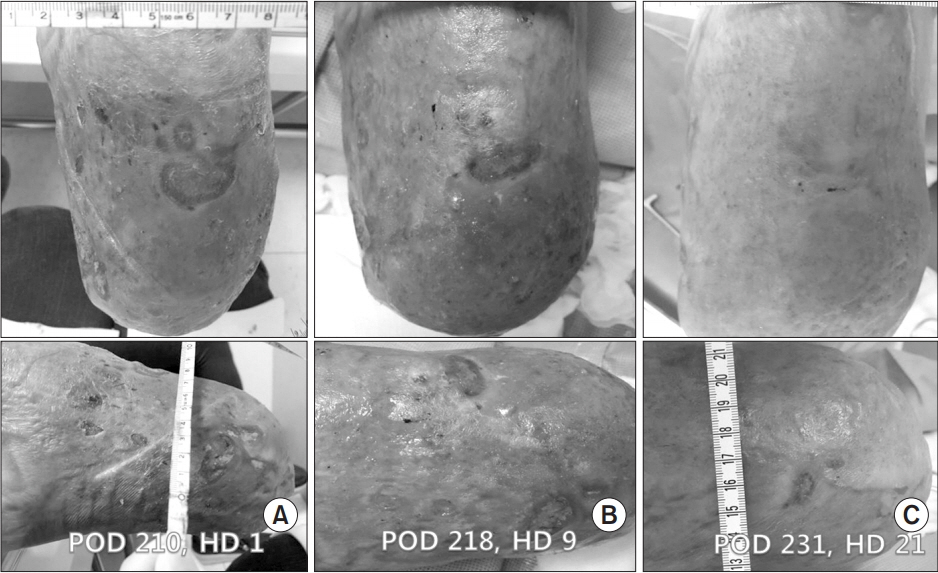Ann Rehabil Med.
2018 Aug;42(4):630-633. 10.5535/arm.2018.42.4.630.
The Effect of Polydeoxyribonucleotide on Chronic Non-healing Wound of an Amputee: A Case Report
- Affiliations
-
- 1Department of Rehabilitation Medicine, Ewha Womans University College of Medicine, Seoul, Korea. acebhs@gmail.com
- KMID: 2420058
- DOI: http://doi.org/10.5535/arm.2018.42.4.630
Abstract
- Polydeoxyribonucleotide (PDRN) is safe and effective in wound healing, cellular growth, synthesis of extracellular matrix protein, and inflammation reduction via activation of adenosine A2 receptors. We report a 28-year-old male patient treated with PDRN injections for chronic non-healing wound refractory to negative pressure wound therapy, skin graft, or growth factors. Three injections of PDRN were administered at the wound site into the anterior and medial sides of the left stump on the 1st, 4th, and 9th days of hospitalization. The PDRN ameliorated wound healing by enhancing cell growth, tissue repair, and angiogenesis. PDRN application represents a potential treatment for non-healing wounds obviating the need for additional therapies, and hospitalization, as well as improve patient's activities of daily living.
Keyword
MeSH Terms
-
Activities of Daily Living
Adult
Amputees*
Extracellular Matrix
Hospitalization
Humans
Inflammation
Intercellular Signaling Peptides and Proteins
Male
Negative-Pressure Wound Therapy
Polydeoxyribonucleotides
Receptors, Adenosine A2
Skin
Transplants
Wound Healing
Wounds and Injuries*
Intercellular Signaling Peptides and Proteins
Polydeoxyribonucleotides
Receptors, Adenosine A2
Figure
Reference
-
1. Kim JY, Pak CS, Park JH, Jeong JH, Heo CY. Effects of polydeoxyribonucleotide in the treatment of pressure ulcers. J Korean Med Sci. 2014; 29 Suppl 3:S222–7.
Article2. Lee DW, Hong HJ, Roh H, Lee WJ. The effect of polydeoxyribonucleotide on ischemic rat skin flap survival. Ann Plast Surg. 2015; 75:84–90.
Article3. Bitto A, Polito F, Altavilla D, Minutoli L, Migliorato A, Squadrito F. Polydeoxyribonucleotide (PDRN) restores blood flow in an experimental model of peripheral artery occlusive disease. J Vasc Surg. 2008; 48:1292–300.
Article4. Altavilla D, Bitto A, Polito F, Marini H, Minutoli L, Di Stefano V, et al. Polydeoxyribonucleotide (PDRN): a safe approach to induce therapeutic angiogenesis in peripheral artery occlusive disease and in diabetic foot ulcers. Cardiovasc Hematol Agents Med Chem. 2009; 7:313–21.
Article5. Pang C, Ibrahim A, Bulstrode NW, Ferretti P. An overview of the therapeutic potential of regenerative medicine in cutaneous wound healing. Int Wound J. 2017; 14:450–9.
Article6. Saltmarche AE. Low level laser therapy for healing acute and chronic wounds: the extendicare experience. Int Wound J. 2008; 5:351–60.7. Sen CK, Gordillo GM, Roy S, Kirsner R, Lambert L, Hunt TK, et al. Human skin wounds: a major and snowballing threat to public health and the economy. Wound Repair Regen. 2009; 17:763–71.
Article8. Menke NB, Ward KR, Witten TM, Bonchev DG, Diegelmann RF. Impaired wound healing. Clin Dermatol. 2007; 25:19–25.
Article9. Insausti CL, Alcaraz A, Garcia-Vizcaino EM, Mrowiec A, Lopez-Martinez MC, Blanquer M, et al. Amniotic membrane induces epithelialization in massive posttraumatic wounds. Wound Repair Regen. 2010; 18:368–77.
Article
- Full Text Links
- Actions
-
Cited
- CITED
-
- Close
- Share
- Similar articles
-
- The Wound Healing Effect of PDRN(polydeoxyribonucleotide) Material on Full Thickness Skin Defect in the Mouse
- Combination treatments employing CO2 fractional lasers with polydeoxyribonucleotide injections for chronic atrophic scar in Republic of Korea: a case report
- The Clinical Uses of Collagen-Based Matrices in the Treatment of Chronic Wounds
- Effects of Polydeoxyribonucleotide in the Treatment of Pressure Ulcers
- Clinical Updates in Polydeoxyribonucleotide Injection


